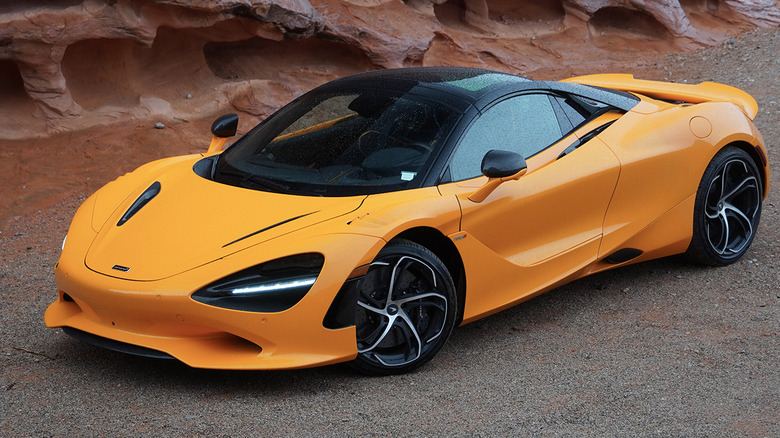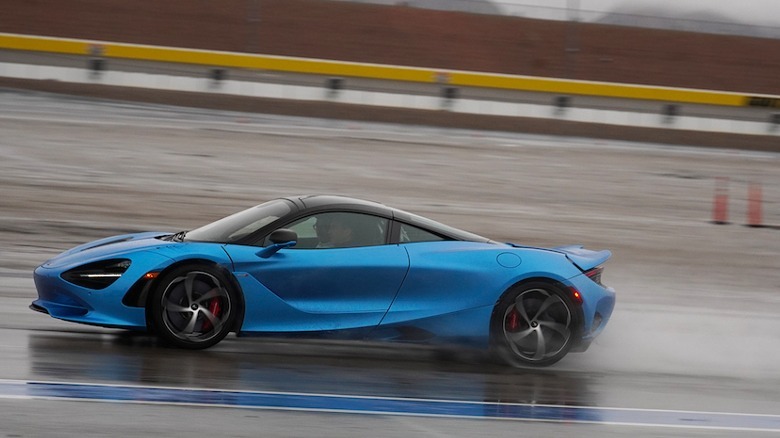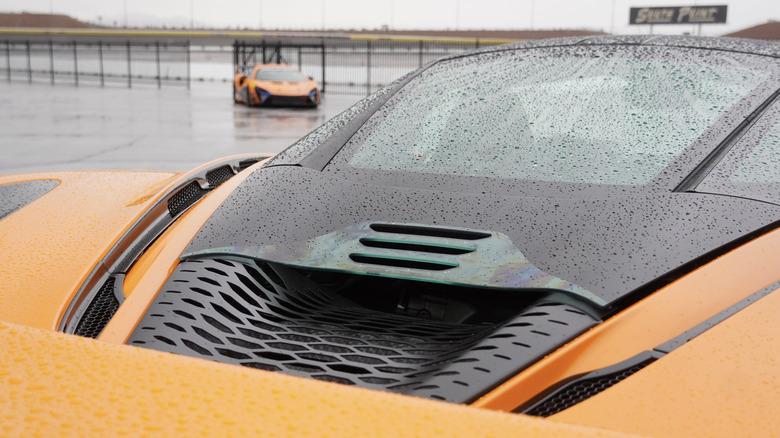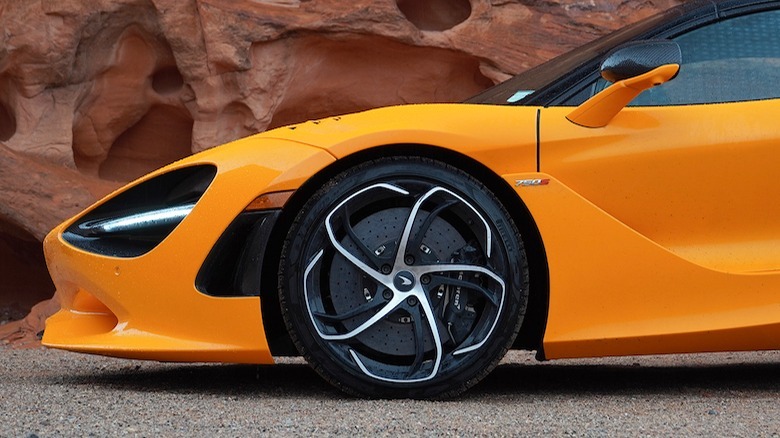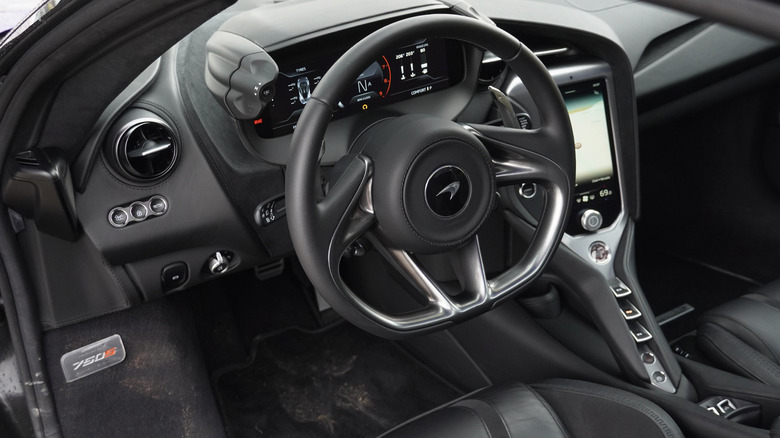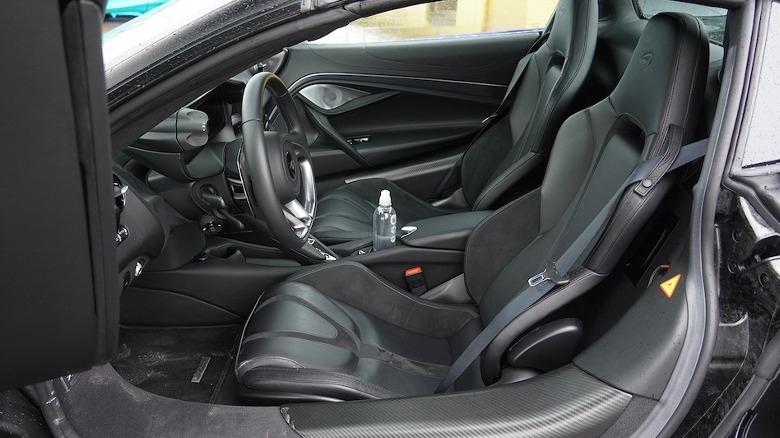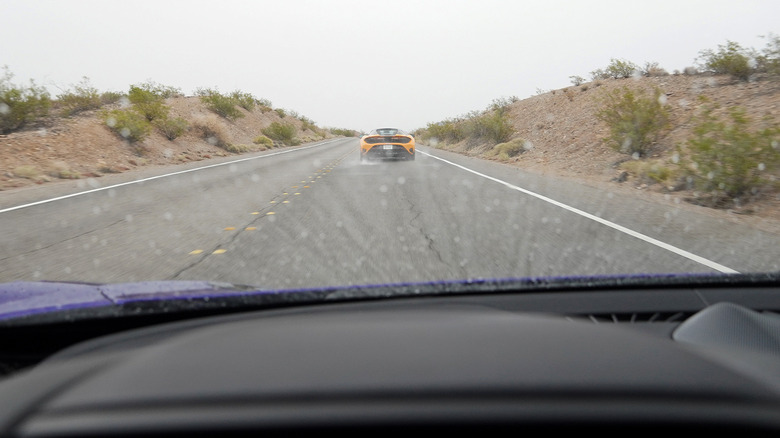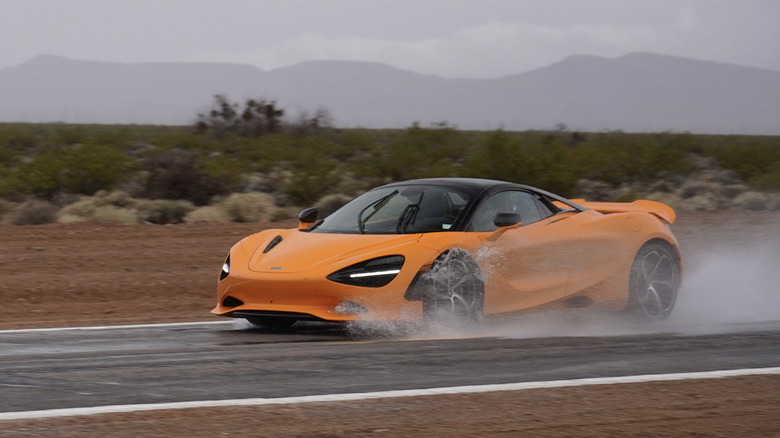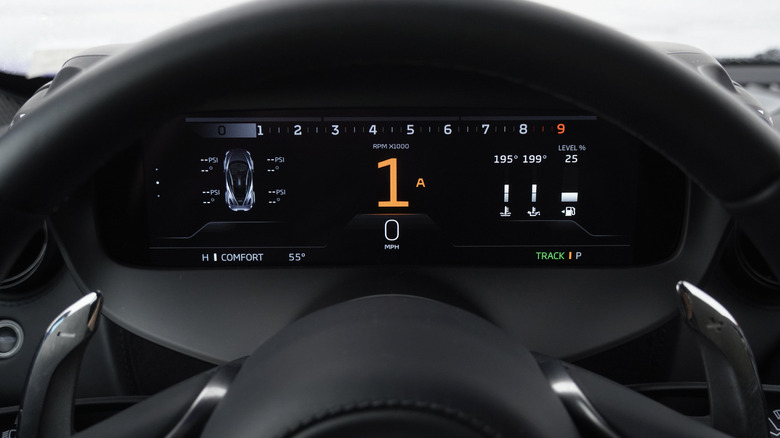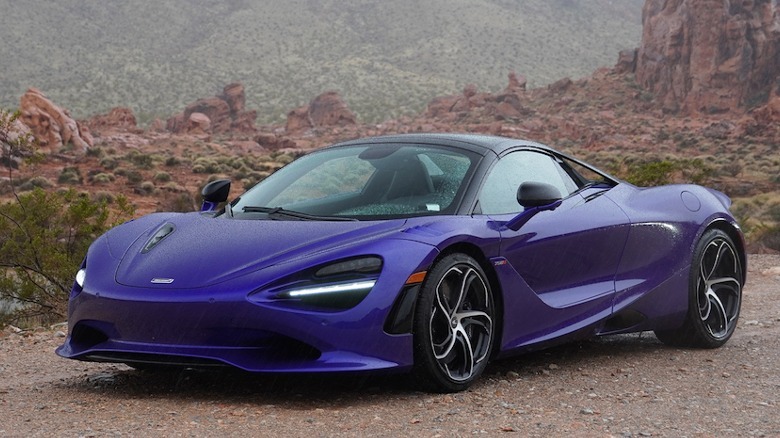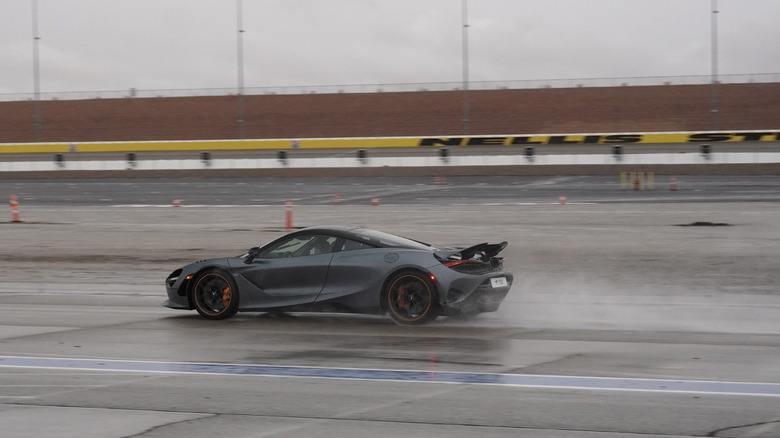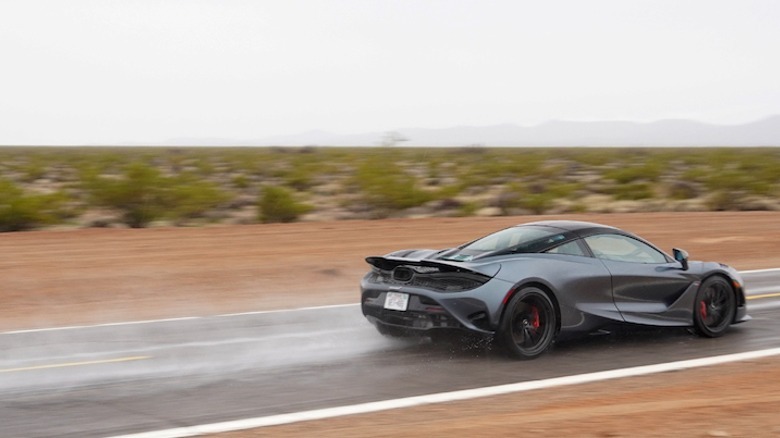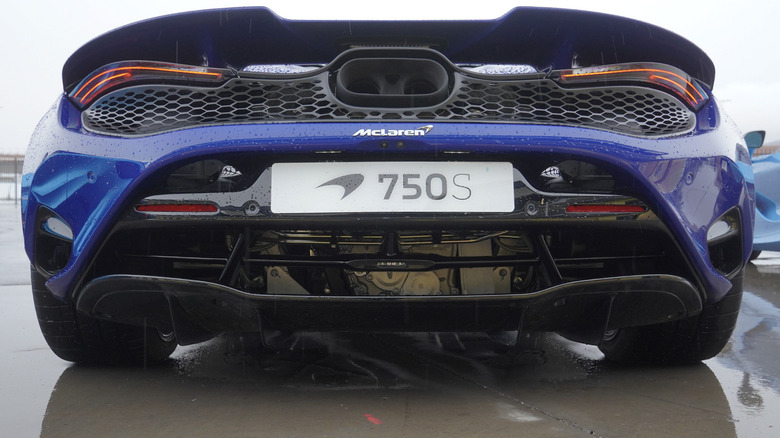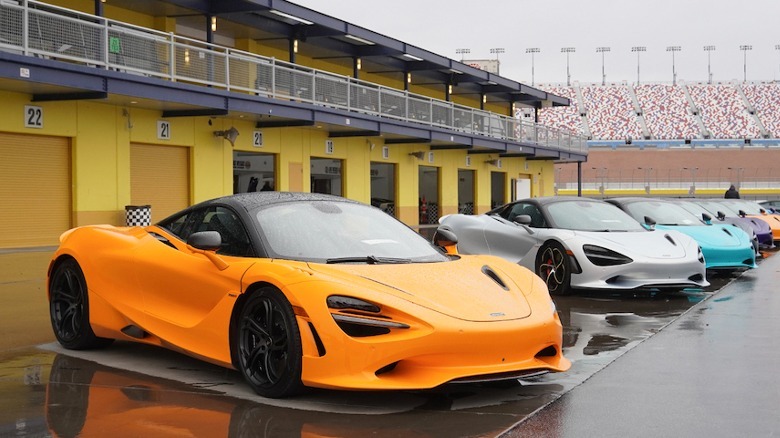2024 McLaren 750S First Drive: Even In The Rain, The Modern Magic Shines Through
All the glitz and glamor of Las Vegas, fresh off last year's inaugural Formula 1 weekend, seemed to provide the perfect setting for McLaren to debut the new 750S supercar for American media. But during a welcome event at the McLaren Experience Center in the Wynn, the collective gathering seemed to wonder why we had assembled from across the country in the largest McLaren press launch ever for a car that seems in nomenclature, specification, and even aesthetics surprisingly similar to the outgoing 720S.
Only eagle-eyed McLaren fans can tell the new 750S apart after the mild facelift. Exterior cosmetic work that can serve as a hint includes the condensed exhaust tips and a unified front bumper-splitter assembly. Would the 750S mark a big enough step for McLaren to warrant the expenditure of putting on such an extravagant press program? Especially given the much more hardcore 765LT situated in the lineup as the 720S's already superior sibling...
Unfortunately, a bit of rain in the forecast turned into a full day of desert drizzle—not exactly ideal for the planned track driving at Las Vegas Motor Speedway. And yet, the conditions proved absolutely perfect for McLaren to prove just how much the 750S represents another giant leap forward in the modern supercar era.
We need to talk about the weather
"You're asking me about the weather?" Kristen Stewart depressingly asked Robert Pattinson in the first Twilight movie. How passé, indeed, but turns out weather becomes a serious subject of conversation when discussing a day out ripping through the desert in a 740-horsepower rear-wheel-drive supercar. That figure steps up modestly from the 710 horsepower of a 720S, made possible by lightweight pistons, dual fuel pumps, higher cylinder pressures, and more boost.
But despite the similarities to a 720S, McLaren reps on hand described the 750S as fully 30% new. Much of the update focused on weight savings, achieved in large part by installing the lightest wheels ever built for a series-production McLaren, as well as optional bucket seats that weigh 38.6 pounds less—each—than the base seats on a 720S. A lightened hood, wing, and exhaust system also slash a few more pounds, resulting in a lowest dry weight of 2,815 pounds for the 750S coupe and just 2,923 pounds for the droptop Spider.
The presentation before any of the media members received 750S keys in hand also hinted at a tighter steering rack, a new brake booster and vacuum pump to improve pedal feel on track and at elevation, all the way to engine mounts that McLaren tuned to enhance the sensation of firing up and dynamic driving while reducing vibrations during sedate cruising. The front track measures 6 millimeters wider, the front-axle lift system now works in four seconds with the touch of one button, a 0-60 run takes 2.7 seconds... But that's in the dry—throughout the whole spiel, everyone just wanted to know when the rain might stop.
Top up or down, just hop in and go
With no sign that the clouds might move along, the time came to bite the proverbial bullet. Misery, thy name is McLaren. But climbing into the 750S revealed major improvements to the misery many 720S customers formerly accepted in the name of owning one of the most spectacular supercars imaginable. Updates to seat design, switchgear layout, and steering wheel adjustment immediately make the 750S a much more welcoming and intuitive car to simply get in and go. In that regard, the 7-Series—if that kind of nomenclature actually applies—now edges nearer to the spectacular 600LT interior. The main concession to frustrations of McLarens past arises when actually adjusting the seats to a comfortable position, still an exercise in absolute, incomprehensible debacle of buttonry.
Meanwhile, new Powertrain and Handling toggles moved to the shoulders of the gauge display — as on the Artura hybrid — allow for the selection between Comfort, Sport, and Track. And the gauge display itself mounts on the steering column a la the limited-production Elva's dash design.
A vertical eight-inch touchscreen supports Apple CarPlay—albeit only wired—and a single big dial controls most of the ways to mess around between menu screens. Bowers & Wilkins contributed the 750S's sound system, which performs alright when not overwhelmed by the twin-turbo V8 engine's soundtrack or wind and tire noise that echoes through the carbon-fiber monocoque at any semblance of reasonable (read: illegal) pace.
On the road again
Getting up to those speeds required first leaving Las Vegas, though, on already rough roads made even rougher by the recent weather. Everyone knows—or should know—about how McLaren's hydro-linked suspension architecture prevents body roll during performance driving without requiring sway bars. But programming a Comfort mode for the Handling settings on the 750S takes that concept to new levels of truly enjoyable cruising. The system now absorbs bumps and potholes without transferring every jolt and jounce into seat bottoms and armrests, despite a set of low-profile Pirelli P-Zero tires mounted on 19 front and 20-inch rear wheels measuring 245 and 305 millimeters wide, respectively.
Washed-out portions of road caused those tires to occasionally produce the racecar clattering of pebbles and dirt sprayed up into the carbon fiber chassis. And the day proved less than ideal for letting the Spider hardtop back, but the tiny rear window rolled down a crack let in much more than hints of engine noise without too many raindrops joining the party. Even with the powertrain set to Comfort, which reduces throttle response and tones back transaxle behavior, the sounds of spooling turbos and runoff burbles crept in as a method for coping with the otherwise dreary drive.
We can't stop here, this is bat country
Eventually, the Las Vegas sprawl gave way to long, flowing roads out into Nevada's spectacular Valley of Fire State Park. The rain even seemed to let off a little! Finally, a chance to toggle into Sport and Track a bit, pushing the 750S harder, asking more of the turbos and gearbox higher up in the rev range. A bit of restraint still seemed prudent, though McLaren still makes the unique decision to separate traction control and ESC programming from the other drive modes, so firming up the suspension and dialing in more power never risked too much tail-happy slippage.
Not too much, note, since a healthy stab at the go pedal still coaxed a bit of windup out of the cold Pirellis. A 15% shorter final drive on the 750S versus the 720S probably explains that fun, peppy nature, inevitably bringing out the inner hooligan while wheeling on wide-open desert roads.
Soft suspension produces stellar supercars
But quick hits of countersteering don't necessarily do the 750S justice. Instead, while rolling through the wavy desert with dampers at full firm, engine spun up near the 8,250-rpm redline, and rain coursing backward on the windshield without requiring wipers, this supercar found a flow almost immediately despite the moist surfaces and repeatedly pulling over onto dirt shoulders hoping to sneak in a moment's respite from the raindrops to snap a few pics.
The 750S gets a set of springs that weigh less than those used on the 720S, but also with a 3% softer nose and 4% stiffer rear setup that brilliantly enhances the ability to shift weight onto the front tires. Soft suspension often serves supercars well, though. Just look at the Huracan Sterrato! For the 750S, only the weirdest sections of heat expansion caused moments of rafting where real sway bars may have managed better. But otherwise, the hours of midday simply flew by, blipping and snarling at downshifts, braking hard with either left or right foot, and then hauling the steering wheel through corners.
Track time cut depressingly short
The reverie ended with a quick loop back down the 15 freeway towards the track, which only looked wet and getting wetter. Brapping sounds echoed from inside the paddock, where air guns ripped off lug nuts to swap on wheels shod in Pirelli P Zero Corsa tires rather than the optional Trofeo R rubber (which, to be fair, would only have exacerbated the coming mess).
Out on a sighting lap, drive instructors warned against full throttle. Maybe giving half gas, 80% if lucky, seemed wise. From behind the wheel, the conditions looked even more dubious. Lateral grip and front-end loading into corners felt fine, but any hint of overzealous acceleration prompted immediate squiggles from the rear tires, requiring a quick hit of opposite-lock to catch drifts before anything went truly wrong.
A few laps in, the car started sliding during gearshifts, even between fourth and fifth at about 5,000 RPM while holding the steering wheel perfectly level on the front straight. Instructors started switching between drive modes, trying to figure out whether Sport or Track coaxed the gearbox into reducing lurches. Lifting off throttle entirely just to shift sure seemed silly, but the Pirelli tires stayed below 80 degrees and simply failed to find purchase. And messing around with settings to produce inconsistent throttle response and shift behavior seemed like possibly the last thing amateurs want to experience while trying to drive as fast as possible without putting a six-figure supercar into a wall. Eventually, wiser forces prevailed and cut the track session short—probably the right call, but still a massive bummer.
The most approachable McLaren ever
Weather prevented anyone from trying out the Spider's retracting roof, the nifty rolling burnout feature, or launch control over the course of the day. And nobody truly felt the aero gains of the 750S's revised bodywork, either, even while watching the active rear wing flip up at every quick chop of throttle or braking. "No comment" should be the official response when anyone asks about top speeds achieved on public roads that day.
But as much as a new McLaren deserves its day in the sun, this wet ride showed exactly how much trust this newly modernized supercar can handle. McLaren always seemed akin to Lotus, in certain regards, just MORE—more of everything, with all caps. Firmer-than-firm brakes, so unique and racy, plus steering almost as close to unassisted as possible, always set McLarens apart from the competition. The 750S arrives in much more malleable form, thanks to updates to brake boosting and steering assist and drive modes, but at what cost? Similar to the new Lotus Emira, increased approachability comes at the risk of diminishing some of the radical edge that makes supercars so enthralling.
Pricing for the 750S coupe starts at $324,000 and a Spider runs about 20 grand more. And rest assured that McLaren will always keep building more expensive, more aggressive LT models for the speed freaks willing to sacrifice comfort in the name of hardcore performance. For now, the 750S delivers a solid statement from Woking about the advantages that modern tech affords supercar manufacturers aiming to attract a broader swath of potential customers. More sales means more money means more racing means more models means, simply put, more McLaren, something every supercar enthusiast—regardless of buying power—can agree the world definitely needs.
